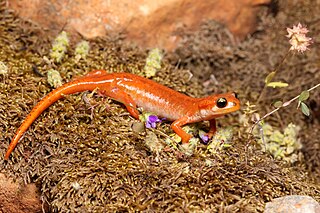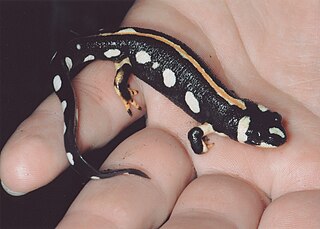
The Chinese fire belly newt is a small black newt, with bright-orange aposematic coloration on their ventral sides. C. orientalis is commonly seen in pet stores, where it is frequently confused with the Japanese fire belly newt due to similarities in size and coloration. C. orientalis typically exhibits smoother skin and a rounder tail than C. pyrrhogaster, and has less obvious parotoid glands. C. orientalis is native to subtropical forests in China and prefers to live in shallow, semiaquatic environments such as abandoned paddies and ponds with dense vegetation.

The fire belly newt or fire newt is a genus (Cynops) of newts native to Japan and China. All of the species show bright yellow or red bellies, but this feature is not unique to this genus. Their skin contains a toxin that can be harmful if ingested.

Tylototriton verrucosus is a species of newt found in the Indian subcontinent and Southeast Asia. Common names include: Himalayan newt, crocodile newt, crocodile salamander, Himalayan salamander, red knobby newt.

Tylototriton is a genus of newts known as crocodile newts or knobby newts. About 36 known species are in this genus. Many species have been described just recently. They range from northeastern India and Nepal through Burma to northern Thailand, Laos, Vietnam, and southern China.

Luschan's salamander or Lycian salamander is a species of salamander in the family Salamandridae. It is found in the southwestern Anatolia in Turkey and adjacent Greece, in the island of Kastellorizo and its satellites.

Neurergus is a genus of salamanders, more specifically newts, in the family Salamandridae. They are found in the Middle East, and are kept and bred in captivity for their bright colors. In nature, they inhabit streams and small rivers, and the surrounding forests or shrublands. All of the Neurergus are considered threatened species, primarily due to destruction of habitat and overcollection for the pet trade.

Paramesotriton, also known as warty newts or Asian warty newts, is a genus of salamanders in the family Salamandridae. The genus is found in southwestern and southern China and in northern Vietnam. Most of the species are endemic to China, and the majority of them have been described recently, since 2008. The genus includes both pond and stream dwellers.

The Italian newt is a species of salamander in the family Salamandridae found only in Italy. The species can be found in temperate forests, temperate shrubland, Mediterranean-type shrubby vegetation, freshwater lakes, intermittent freshwater lakes, freshwater marshes, intermittent freshwater marshes, arable land, pastureland, rural gardens, water storage areas, ponds, and canals and ditches. It is threatened by habitat loss, natural land conversion and invasive species. It was formerly known as Triturus italicus, but was relocated to the genus Lissotriton after Triturus was split.

Ommatotriton or banded newts is a genus of salamanders in the family Salamandridae. The genus occurs in Western Asia and Caucasus. The species in this genus were formerly placed in the genus Triturus.

A newt is a salamander in the subfamily Pleurodelinae. The terrestrial juvenile phase is called an eft. Unlike other members of the family Salamandridae, newts are semiaquatic, alternating between aquatic and terrestrial habitats. Not all aquatic salamanders are considered newts, however. More than 100 known species of newts are found in North America, Europe, North Africa and Asia. Newts metamorphose through three distinct developmental life stages: aquatic larva, terrestrial juvenile (eft), and adult. Adult newts have lizard-like bodies and return to the water every year to breed, otherwise living in humid, cover-rich land habitats.

Lissotriton is a genus of newts native to Europe and parts of Asia Minor. As most other newts, they are aquatic as larvae and during breeding time but live in terrestrial, humid environments over the rest of the season.

Poisonous amphibians are amphibians that produce toxins to defend themselves from predators.
The Fuding fire belly newt is a rare species of newt in the family Salamandridae, endemic to China. It is only known from Fuding in northeastern Fujian, from the locality where it was described as a new species in 2010. Although it is genetically similar to the Chinese fire belly newt, it is morphologically more similar to the Dayang fire belly newt. The range of C. fudingensis is separate from both other species.

Batrachochytrium salamandrivorans (Bsal) is a pathogenic chytrid fungus that infects amphibian species. Although salamanders and newts seem to be the most susceptible, some anuran species are also affected. Bsal has emerged recently and poses a major threat to species in Europe and North America.
Pachytriton inexpectatus is a species of salamander in the family Salamandridae. It is endemic to southern China and found in the Guizhou, Hunan, Guangdong, and Guangxi provinces. Its type locality is Mount Dayao of Jinxiu Yao Autonomous County, Guangxi. Prior to naming of this species in 2011, it was confused with Pachytriton labiatus. It is one of the several species that can appear in the pet trade as paddletail newt. The specific name inexpectatus is Latin meaning "unexpected" and refers to finding a species that is common in pet trade but lacked formal scientific description. Common name Yaoshan stout newt has been coined specifically for this species.














